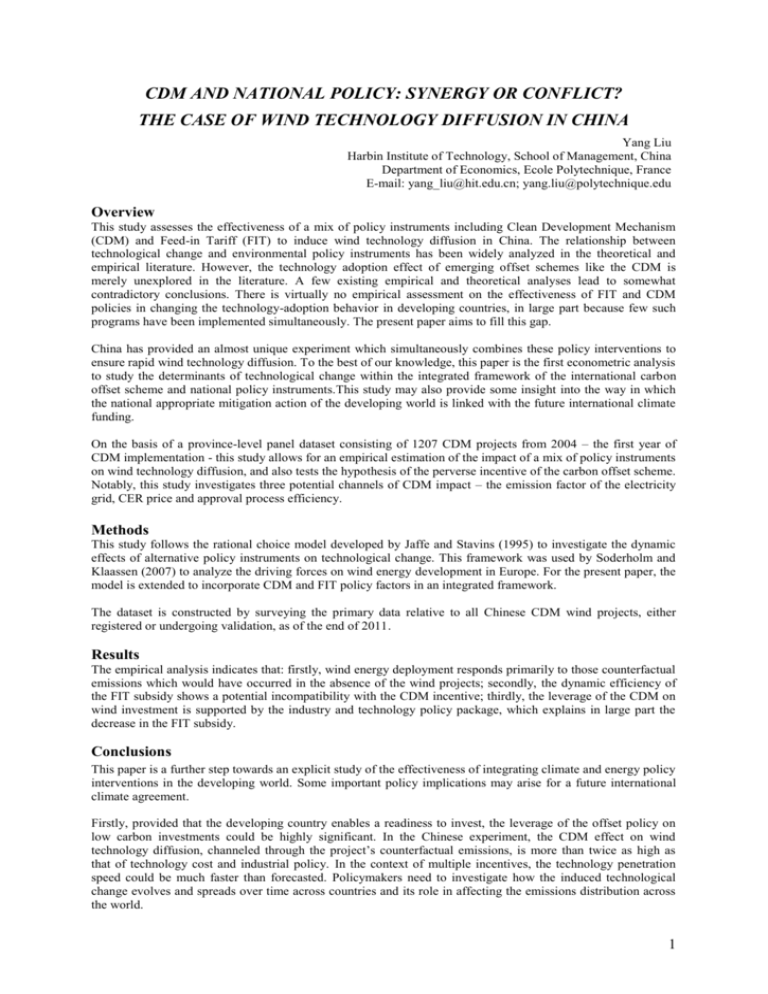Bridging renewable electricity subsidy with carbon offset scheme
advertisement

CDM AND NATIONAL POLICY: SYNERGY OR CONFLICT? THE CASE OF WIND TECHNOLOGY DIFFUSION IN CHINA Yang Liu Harbin Institute of Technology, School of Management, China Department of Economics, Ecole Polytechnique, France E-mail: yang_liu@hit.edu.cn; yang.liu@polytechnique.edu Overview This study assesses the effectiveness of a mix of policy instruments including Clean Development Mechanism (CDM) and Feed-in Tariff (FIT) to induce wind technology diffusion in China. The relationship between technological change and environmental policy instruments has been widely analyzed in the theoretical and empirical literature. However, the technology adoption effect of emerging offset schemes like the CDM is merely unexplored in the literature. A few existing empirical and theoretical analyses lead to somewhat contradictory conclusions. There is virtually no empirical assessment on the effectiveness of FIT and CDM policies in changing the technology-adoption behavior in developing countries, in large part because few such programs have been implemented simultaneously. The present paper aims to fill this gap. China has provided an almost unique experiment which simultaneously combines these policy interventions to ensure rapid wind technology diffusion. To the best of our knowledge, this paper is the first econometric analysis to study the determinants of technological change within the integrated framework of the international carbon offset scheme and national policy instruments.This study may also provide some insight into the way in which the national appropriate mitigation action of the developing world is linked with the future international climate funding. On the basis of a province-level panel dataset consisting of 1207 CDM projects from 2004 – the first year of CDM implementation - this study allows for an empirical estimation of the impact of a mix of policy instruments on wind technology diffusion, and also tests the hypothesis of the perverse incentive of the carbon offset scheme. Notably, this study investigates three potential channels of CDM impact – the emission factor of the electricity grid, CER price and approval process efficiency. Methods This study follows the rational choice model developed by Jaffe and Stavins (1995) to investigate the dynamic effects of alternative policy instruments on technological change. This framework was used by Soderholm and Klaassen (2007) to analyze the driving forces on wind energy development in Europe. For the present paper, the model is extended to incorporate CDM and FIT policy factors in an integrated framework. The dataset is constructed by surveying the primary data relative to all Chinese CDM wind projects, either registered or undergoing validation, as of the end of 2011. Results The empirical analysis indicates that: firstly, wind energy deployment responds primarily to those counterfactual emissions which would have occurred in the absence of the wind projects; secondly, the dynamic efficiency of the FIT subsidy shows a potential incompatibility with the CDM incentive; thirdly, the leverage of the CDM on wind investment is supported by the industry and technology policy package, which explains in large part the decrease in the FIT subsidy. Conclusions This paper is a further step towards an explicit study of the effectiveness of integrating climate and energy policy interventions in the developing world. Some important policy implications may arise for a future international climate agreement. Firstly, provided that the developing country enables a readiness to invest, the leverage of the offset policy on low carbon investments could be highly significant. In the Chinese experiment, the CDM effect on wind technology diffusion, channeled through the project’s counterfactual emissions, is more than twice as high as that of technology cost and industrial policy. In the context of multiple incentives, the technology penetration speed could be much faster than forecasted. Policymakers need to investigate how the induced technological change evolves and spreads over time across countries and its role in affecting the emissions distribution across the world. 1 Secondly, concerning the incentive incompatibility of the carbon offset scheme, the mix of industrial and technology policies may reduce the renewable electricity support and lead to a high “signal-to-noise” situation, in which the perverse incentive may not be effectively verified and prevented. For future global climate cooperation, the sectoral approach is intended to expand the carbon market, especially in emerging countries like China. If the CDM is a framework in which more ambitious policies can be accommodated, a coordinated mechanism is needed to address potential trade-offs between global and national incentives at the sector-wide level. This study suggests that the technology penetration rate and emission factor of the electricity system could be two efficient monitoring parameters to set up consistency between climate finance and domestic policy instruments in the renewable electricity sector. Finally, an efficient policy package is becoming one of the most important determinants of wind technology diffusion. China’s leapfrog in wind energy occurred when relatively mature wind technology had already been widely used in developed countries. The marginal cost reduction of technology deployment is decreasing, and public policy may thus play a dominant role. Therefore, more attention should be devoted to the cross-border interdependence of these policy instruments addressing climate and energy challenges. References Jaffe, A.B., Stavins, R.N., 1995. Dynamic incentives of environmental regulations: the effects of alternative policy instruments on technology diffusion, Journal of Environmental Economics and Management 29, 43-63. Soderholm, P, Klaassen G., 2007. Wind power in Europe: A simultaneous innovation-diffusion model, Environmental and Resource Economics 36, 163-190. 2







